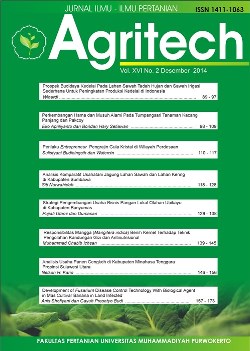PENGARUH KOMBINASI 2,4-D DAN BENZIL AMINO PURIN (BAP) TERHADAP PEMBENTUKAN KALUS PADA EKSPLAN DAUN KENCUR (Kaemferia galangal L) SECARA IN VITRO
DOI:
https://doi.org/10.30595/agritech.v12i2.992Abstract
This research aim to learn the influence of combination of concentration plant growth regulator 2,4-D and BAP to callus induction at eksplan of Koempheria galanga leaf, proliferasi callus at eksplan and also know the interaction influence between 2,4-D and BAP to obtaining culture of callus Koempheria galanga which its growth good. This research was conducted from April to September 2010, in Laboratory of Tissue Culture, FKIP, University of Muhammadiyah Purwokerto. The Trial was arranged in Complete Random Design (CRD). Perception variable cover the : time induce the callus, percentage explant growth, callus volume which grow from explants leaf , culture appearance visually and percentage contamination. Result of research indicate that the Combination of concentration of Plant growth regulator 2,4-D at concentration 0 - 2 mg / l of medium and BAP at] concentration 0 - 0,3 mg / l medium still not yet able to induce formed is callus at eksplan of leaf Koempheria galanga during research. Disability Explants form the callus because of fenol high rate enough in tissue explant and also not yet proportional it concentration 2,4 D and Benzil Aminopurin which can depress the sintesis fenol in and death at explant of koempheria galanga leaf.Downloads
Issue
Section
License
Authors who publish with this journal agree to the following terms:
Authors retain copyright and grant the journal right of first publication with the work simultaneously licensed under a Creative Commons Attribution 4.0 International License that allows others to share the work with an acknowledgement of the work's authorship and initial publication in this journal.
Authors are able to enter into separate, additional contractual arrangements for the non-exclusive distribution of the journal's published version of the work (e.g., post it to an institutional repository or publish it in a book), with an acknowledgement of its initial publication in this journal.
Authors are permitted and encouraged to post their work online (e.g., in institutional repositories or on their website) prior to and during the submission process, as it can lead to productive exchanges, as well as earlier and greater citation of published work (See The Effect of Open Access).

This work is licensed under a Creative Commons Attribution 4.0 International License.


